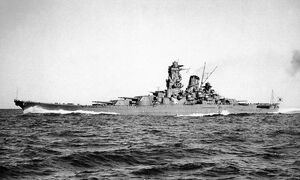The Yamato-class battleship was the largest class of battleships ever built. The Yamato was named after the ancient Japanese Yamato Province, with the Yamato serving as the flagship of Imperial Japanese Navy battleships during World War II. The Yamato and her sister ship, Musashi, were the heaviest and most powerfully armed battleships ever constructed, displacing 72,800 tonnes at full load and was armed with nine 46 cm (18.1 inch) main guns, split equally between the ship's three turrets. Neither ship survived the war.
History
Laid down in 1937 and formally commission a week after the Pearl Harbor attack in late 1941, Yamato was designed to counter the numerically superior battleship fleet of the United States, Japan's main rival in the Pacific. Throughout 1942 she served as the flagship of the Japanese Combined Fleet, and in June 1942 Admiral Isoroku Yamamoto directed the fleet from her bridge during the Battle of Midway, a disastrous defeat for Japan. Musashi took over as the Combined Fleet flagship in early 1943, and Yamato spent the rest of the year, and much of 1944, moving between the major Japanese naval bases of Truk and Kure in response to American threats. Although she was present at the Battle of the Philippine Sea in June 1944, Yamato played no part in the battle. The only time she fired her main guns at enemy surface targets was in October 1944, when she was sent to engage American forces invading the Philippines during the Battle of Leyte Gulf, the same battle which claimed her sister ship, the Musashi, and two other Japanese battleships. On the verge of success, the Japanese force turned back, believing they were engaging an entire US carrier fleet rather than the light escort carrier group that was all that stood between Yamato and the vulnerable troop transports. During 1944 the balance of naval power in the Pacific decisively turned against Japan and, by early 1945, the Japanese fleet was much depleted and critically short of fuel stocks in the home islands, limiting its usefulness. In April 1945, in a desperate attempt to slow the Allied advance, Yamato was dispatched on a one-way voyage to Okinawa, where it was intended that she should protect the island from invasion and fight until destroyed. The task force was spotted south of Kyushu by US submarines and aircraft, and on 7 April 1945 she was sunk by American carrier-based bombers and torpedo bombers with the loss of most of her crew.
In-Game Depiction[]
The Yamato-class battleship serves as a naval target in the Pacific campaign. As one of the most powerful class of ships, the Yamato, like other battleships, take a considerable amount of damage. The following is a list of how many of a specific type of ordnance it takes to knock out the Yamato:
- 2x 4000lbs bombs
- 3x 2000lbs/1000kg bombs
- 7x 500kg bombs
- 23x 250kg/500lbs bombs
- 4-5x Torpedoes



